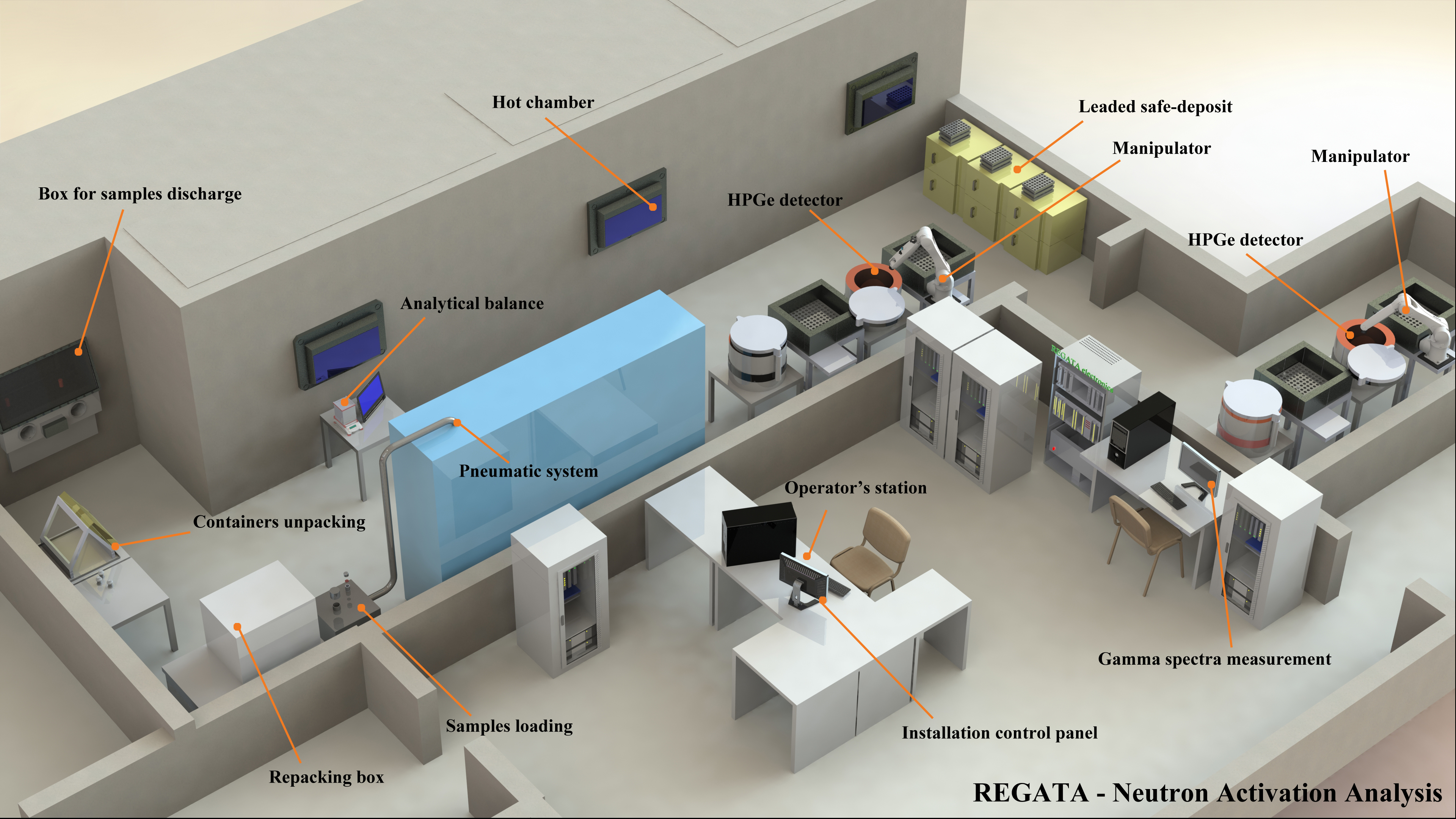Responsible for the facility
Zinicovscaia Inga
e-mail: This email address is being protected from spambots. You need JavaScript enabled to view it.
tel. +7 (496) 21 6-56-09
Main research areas:
- Air quality monitoring (aerosol filter surveys, biomonitoring using mosses, lichens, leaves)
- Estimation of the state of water objects
- Soil bioremediation and wastewater treatment
- Geology and geoecology
- Analysis of food, medicinal plants
- Nanotoxicology
- Materials science
- Biotechnology (development of new medicines and sorbents)
- Archeology
- Analysis of objects of extraterrestrial origin
Facility layout
Main view of facility
Description of REGATA
The REGATA pneumatic transport unit (PTU) of IBR-2 is designed to determine the elemental composition of investigated samples using the Neutron Activation Analysis method. The method is based on the nuclear-physical process of interaction of stable nuclei of units with neutrons during irradiation of test and standard samples in the neutron flux of the nuclear reactor. As a result of the interaction, radioactive nuclides are produced. Each radionuclide has a certain decay rate of radioactivity that is characterized by T1/2 half-decay and also has a unique gamma-ray spectrum (distribution of gamma-quanta in energies and intensities).
Irradiation at the REGATA facility is carried out in two horizontal experimental beamlines of the reactor. Transportation capsules with samples are transferred to the irradiation beamlines positioned near the moderators of the reactor core using a pneumatic transport unit. In the irradiation beamline B2, irradiation is carried out with the full spectrum of reactor neutrons. The thermal neutron flux density in this beamline is about 2x1012 cm-2s-1. The second irradiation beamline B1 has a cadmium casing, so irradiation is mainly implemented using resonant and fast neutrons. The flux density of resonant neutrons in beamline B1 is about 1.5x1011 cm-2s-1. As a rule, beamline B2 is used for short irradiation (SLI) and B1 for long irradiation (LLI). The duration of irradiation of samples is selected based on the type of samples to be analyzed, their mass and also on the type of units to be analyzed (short-lived or long-lived radioactive isotopes obtained).
Approximate duration of irradiation of samples on the beamlines of the IBR-2 reactor Object of analysis Duration of irradiation SLI (sec.) LLI (hour) Soils, sediments, bottom sediments 60-120 70-100 Rocks, ores, ore enrichment and processing products 60-120 5-100* Solid materials of plant origin 180-300 70-100 Solid materials of animal origin 180-300 70-100 *The duration of irradiation of samples is determined after the analysis of the spectra of short-lived isotopes and the determination of possible high units of elements that produce long-lived nuclides after irradiation. The same procedure should be carried out when analyzing technological, medical and other samples that may contain a high content of units that produce long-lived isotopes. After irradiation of such samples, the activities can be very high that allows to measure the spectra.
After irradiation, the gamma radiation spectra of radionuclides are measured using spectrometers based on high-purity germanium (HPGe) semiconductor detectors and high-resolution spectrum analyzers. As a rule, measurements of the SLI spectra are produced simultaneously on 3 or 4 detectors (according to the number of irradiated samples). These measurements are carried out without extra post-irradiation exposure immediately after the samples are repackaged into clean capsules. The LLI spectra are measured twice (LLI-1 and LLI-2). The first time - after 3-5 days’ exposure after irradiation (within 30 minutes) and the second time - 19-22 days after irradiation (within 90 minutes).
The spectra are processed using the software of the spectrometers used. Nuclides are identified by comparing the energies of the peaks detected in the spectrum with lineation in the nuclide library used in spectrum processing. Thus, the peak energy in the spectrum allows to determine the type of nuclide and the peak area is proportional to the initial number of unit nuclei, that is, mass fraction of the unit in the test sample.
Calculation of the content (mass fraction) of units in the test sample is carried out by comparing the activity of the same nuclide in the analyzed sample and the standard sample irradiated together (in the same conditions) with the known and certified value of the mass fraction of this unit. During irradiation under different conditions, neutron flux monitors are used to correct the calculated activity. Reference samples (RS) are standard samples of the composition with known contents of units that are selected in such a way that they are as close as possible to the test samples in terms of composition, structure and contents of the units being determined.
Basic parameters Items to be determined Na, Mg, Al, Si, S, Cl, K, Ca, Sc, Ti, V, Cr, Mn, Fe, Co, Ni, Zn, As, Se, Br, Sr, Y, Zr, Nb, Mo, Ag, In, Rb, Sn, Sb, I, Cs, Ba, La, Ce, Sm, Eu, Gd, Tb, Dy, Nd, Er, Tm, Yb, Lu, Hf, Ta, W, Re, Ir, Au, Hg, Th, U Air pressure 3-7 bar Transportation containers Polyethylene, Teflon, Aluminum Internal volume of transportation containers 3.5 – 5.5 cm3 Thermal neutron flux 1.5× 1012 n/s cm2 Resonance neutron flux 2,0× 1011 n/s cm2 Mass of sample (depends on the type of sample) 50 mg – several grams
Publications
ФР.1.31.2021.41736 МП ОИЯИ 01-2021. Определение содержаний (массовой доли) химических элементов (Na, Al, Cl, K, Ca, Sc, Ti, V, Cr, Mn, Fe, Co, Ni, Zn, As, Sr, Rb, Sb, Cs, Ba, La, Ce, Tb, Hf, Ta, Th, U) в твердых объектах окружающей среды и технологических сред инструментальным нейтронно-активационным методом. № свидетельства об аттестации: 348/2021-01.00115-2013 (31.05.2021).
